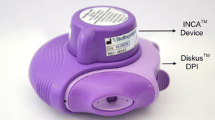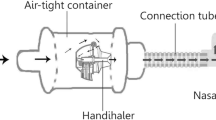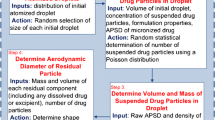Abstract
Purpose
This study investigated the effect of oropharyngeal geometry on inhaled aerosol characteristics via pressurised metered dose inhalers (pMDIs), both with or without spacers.
Methods
Seven adult oropharyngeal models with different centreline lengths, total volumes, and degrees of constriction were employed as induction ports for a laser diffraction particle size analyser and cascade impactor. Particle size change over time, mass median aerodynamic diameter (MMAD), average median volume diameter (DV50), inhaled doses, and oropharyngeal depositions (percentage of the nominal dose) for aerosols via suspension and ultrafine pMDIs with or without spacers at 30 l/min airflow were determined.
Results
Variations in oropharyngeal geometry caused significant variations in inhaled particle size distributions, doses, oropharyngeal drug depositions, and particle size change over time when pMDIs were used without spacers. However, inhaled aerosol characteristics had marginal variations for the ultrafine pMDI plus large volume spacer (MMAD range: 0.69–0.78 µm, DV50 range: 1.27–1.36 µm, inhaled dose range: 46.46–52.92%). It was found that the amounts of inhaled aerosol particles with aerodynamic size of less than 0.83 µm via pMDIs plus large volume spacer were slightly affected by the oropharyngeal geometry.
Conclusion
Inhaling ultrafine aerosols via spacers may reduce the effect of oropharyngeal geometry on inhaled aerosol properties.







Similar content being viewed by others
References
Laube BL. The expanding role of aerosols in systemic drug delivery, gene therapy, and vaccination. Respir Care. 2005;50:1161–76.
Karpel JP, Aldrich TK, Prezant DJ, Guguchev K, Gaitan-Salas A, Pathiparti R. Emergency treatment of acute asthma with albuterol metered-dose inhaler plus holding chamber: how often should treatments be administered? Chest. 1997;112:348–56.
Dolovich MB, Ahrens RC, Hess DR, Anderson P, Dhand R, Rau JL, et al. American College of Chest Physicians; American College of Asthma, Allergy, and Immunology. Device selection and outcomes of aerosol therapy: Evidence-based guidelines: American College of Chest Physicians/American College of Asthma, Allergy, and Immunology. Chest. 2005;127:335–71.
Szefler SJ, Martin RJ, King TS, Boushey HA, Cherniack RM, Chinchilli VM, et al. Asthma Clinical Research Network of the National Heart Lung, and Blood Institute. Significant variability in response to inhaled corticosteroids for persistent asthma. J Allergy Clin Immunol. 2002;109:410–8.
Borgström L, Derom E, Ståhl E, Wåhlin-Boll E, Pauwels R. The inhalation device influences lung deposition and bronchodilating effect of terbutaline. Am J Respir Crit Care Med. 1996;153:1636–40.
Borgström L, Olsson B, Thorsson L. Degree of throat deposition can explain the variability in lung deposition of inhaled drugs. J Aerosol Med. 2006;19:473–83.
Dunbar C, Scheuch G, Sommerer K, DeLong M, Verma A, Batycky R. In vitro and in vivo dose delivery characteristics of large porous particles for inhalation. Int J Pharm. 2002;245:179–89.
Svartengren K, Lindestad P, Svartengren M, Philipson K, Bylin G, Camner P. Added external resistance reduces oropharyngeal deposition and increases lung deposition of aerosol particles in asthmatics. Am J Respir Crit Care Med. 1995;152:32–7.
Svartengren K, Anderson M, Svartengren M, Philipson K, Camner P. Oropharyngeal deposition of 3.5 microns particles inhaled through an elongated mouthpiece. Eur Respir J. 1996;9:1556–9.
De Boeck K, Alifier M, Warnier G. Is the correct use of a dry powder inhaler (Turbohaler) age dependent? J Allergy Clin Immunol. 1999;103:763–7.
Burnell PK, Asking L, Borgström L, Nichols SC, Olsson B, Prime D, et al. Studies of the human oropharyngeal airspaces using magnetic resonance imaging IV–the oropharyngeal retention effect for four inhalation delivery systems. J Aerosol Med. 2007;20:269–81.
Ehtezazi T, Allanson DR, Jenkinson ID, O’Callaghan C. Effect of oropharyngeal length in drug lung delivery via suspension pressurized metered dose inhalers. Pharm Res. 2006;23:1364–72.
Janssens HM, De Jongste JC, Hop WC, Tiddens HA. Extra-fine particles improve lung delivery of inhaled steroids in infants: a study in an upper airway model. Chest. 2003;123:2083–8.
Leach CL, Davidson PJ, Hasselquist BE, Boudreau RJ. Lung deposition of hydrofluoroalkane-134a beclomethasone is greater than that of chlorofluorocarbon fluticasone and chlorofluorocarbon beclomethasone: a cross-over study in healthy volunteers. Chest. 2002;122:510–6.
Ehtezazi T, Horsfield MA, Barry PW, O’Callaghan C. Dynamic change of the upper airway during inhalation via aerosol delivery devices. J Aerosol Med. 2004;17:325–34.
Ehtezazi T, Southern KW, Allanson D, Jenkinson I, O’Callaghan C. Suitability of the upper airway models obtained from MRI studies in simulating drug lung deposition from inhalers. Pharm Res. 2005;22:166–70.
Lin TC, Breysse PN, Laube BL, Swift DL. Mouthpiece diameter affects deposition efficiency in cast models of the human oral airways. J Aerosol Med. 2001;14:335–41.
Wildhaber JH, Devadason SG, Eber E, Hayden MJ, Everard ML, Summers QA, et al. Effect of electrostatic charge, flow, delay and multiple actuations on the in vitro delivery of salbutamol from different small volume spacers for infants. Thorax. 1996;51:985–8.
Mitchell PJ, Nagel MW, Wiersema KJ, Doyle CC. Aerodynamic particle size analysis of aerosols from pressurised metered dose inhalers: Comparison of Anderson 8-stage cascade impactor, next generation pharmaceutical impactor, and model 3321 aerodynamic particle sizer aerosol spectrometer. AAPS PharmSciTech. 2003;4:1–9.
Volovitz B, Bilavsky E, Nussinovitch M. Effectiveness of high repeated doses of inhaled budesonide or fluticasone in controlling acute asthma exacerbations in young children. J Asthma. 2008;45:561–7.
British Thoracic Society Scottish Intercollegiate Guidelines Network. British Guideline on the Management of Asthma. Thorax. 2008;63:iv1–121.
Nyambura BK, Kellaway IW, Taylor KM. Insulin nanoparticles: stability and aerosolization from pressurized metered dose inhalers. Int J Pharm. 2009;375:114–1122.
Wu L, Al-Haydari M, da Rocha SR. Novel propellant-driven inhalation formulations: engineering polar drug particles with surface-trapped hydrofluoroalkane-philes. Eur J Pharm Sci. 2008;33:146–58.
Martin AR, Finlay WH. The effect of humidity on the size of particles delivered from metered-dose inhalers. Aerosol Sci Tech. 2005;39:283–9.
Martonen TB, Bell KA, Phalen RF, Wilson AF, Ho A. Growth rate measurements and deposition modelling of hygroscopic aerosols in human tracheobronchial models. Ann Occup Hyg. 1982;26:93–108.
Hickey AJ, Martonen TB. Behavior of hygroscopic pharmaceutical aerosols and the influence of hydrophobic additives. Pharm Res. 1993;10:1–7.
Garrett J, Williams S, Wong C, Holdaway D. Treatment of acute asthmatic exacerbations with an increased dose of inhaled steroid. Arch Dis Child. 1998;79:12–7.
Svartengren K, Philipson K, Svartengren M, Anderson M, Camner P. Tracheobronchial deposition and clearance in small airways in asthmatic subjects. Eur Respir J. 1996;9:1118–22.
Aswania O, Ritson S, Iqbal SM, Bhatt J, Rigby AS, Everard ML. Intra-subject variability in lung dose in healthy volunteers using five conventional portable inhalers. J Aerosol Med. 2004;17:231–8.
Borgström L, Bengtsson T, Derom E, Pauwels R. Variability in lung deposition of inhaled drug, within and between asthmatic patients, with a pMDI and a dry powder inhaler, Turbuhaler. Int J Pharm. 2000;193:227–30.
Usmani OS, Biddiscombe MF, Barnes PJ. Regional lung deposition and bronchodilator response as a function of beta2-agonist particle size. Am J Respir Crit Care Med. 2005;172:1497–504.
Mazhar SH, Ismail NE, Newton DA, Chrystyn H. Relative lung deposition of salbutamol following inhalation from a spacer and a Sidestream jet nebulizer following an acute exacerbation. Br J Clin Pharmacol. 2008;65:334–7.
Roller CM, Zhang G, Troedson RG, Leach CL, Le Souëf PN, Devadason SG. Spacer inhalation technique and deposition of extrafine aerosol in asthmatic children. Eur Respir J. 2007;29:299–306.
Onhøj J, Thorsson L, Bisgaard H. Lung deposition of inhaled drugs increases with age. Am J Respir Crit Care Med. 2000;162:1819–22.
Smyth H, Hickey AJ, Brace G, Barbour T, Gallion J, Grove J. Spray pattern analysis for metered dose inhalers I: orifice size, particle size, and droplet motion correlations. Drug Dev Ind Pharm. 2006;32:1033–41.
Acknowledgment
We would like to take this opportunity to express our gratitude to Sympatec Ltd, Waterfold House, Bury, BL9 7BR for providing use of the Sympatec HELOS BF/MAGIC® system with the Inhaler 2000 module to perform this study. We would like to thank Mr. Jonathan Veal and Mr. Anthony Dunmore for their technical assistance. The original MRI data to manufacture the oropharyngeal models were obtained from a study that was sponsored by AstraZeneca R&D Charnwood, and this study was reported previously (15).
Author information
Authors and Affiliations
Corresponding author
Electronic supplementary material
Below is the link to the electronic supplementary material.
On-line Supplementary Material
A) Midsaggital magnetic resonance images of subjects while inhaling via inhalers. B) Cross sectional area distributions of the 2C, 4A, 5A, and 6B oropharyngeal geometries via a circular mouthpiece and low airflow resistance device. C) Cross sectional area distributions of the 1C, 3A, and 7B oropharyngeal geometries via a rectangular mouthpiece and low airflow resistance device. Open circular symbols present the 1C geometry, filled circular symbols show the 2C geometry, open square symbols depict the 3A geometry, filled triangle symbols depict the 4A geometry, filled square symbols illustrate the 5A geometry, filled diamond symbols present the 6B geometry, and open diamond symbols illustrate the 7B geometry.
High resolution image
(TIFF 220 kb)
Rights and permissions
About this article
Cite this article
Ehtezazi, T., Saleem, I., Shrubb, I. et al. The Interaction Between the Oropharyngeal Geometry and Aerosols via Pressurised Metered Dose Inhalers. Pharm Res 27, 175–186 (2010). https://doi.org/10.1007/s11095-009-9994-z
Received:
Accepted:
Published:
Issue Date:
DOI: https://doi.org/10.1007/s11095-009-9994-z




